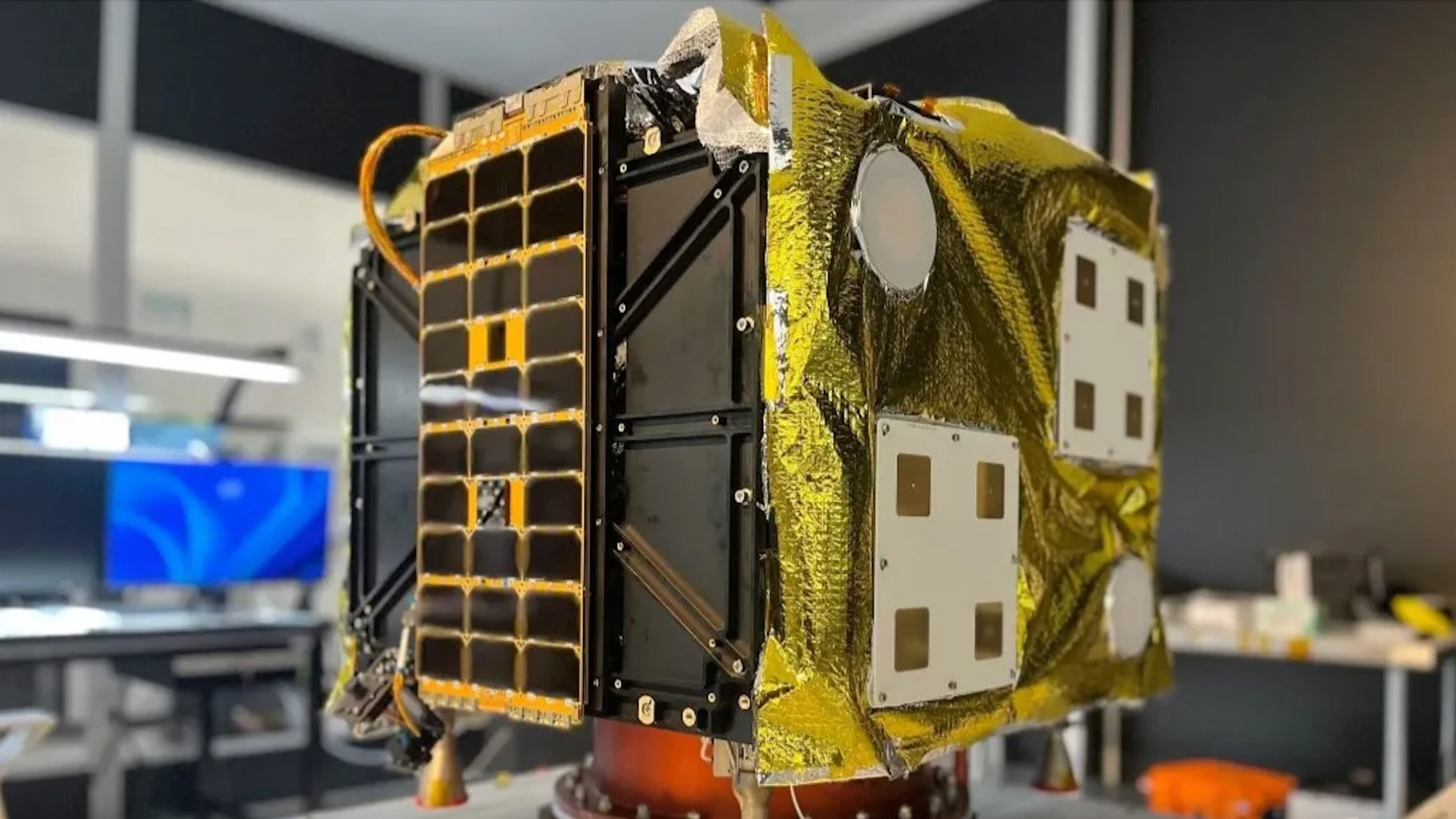1st private spacecraft to attempt to travel beyond the moon appears to be in trouble
"We don't fully understand the state of the vehicle."

The first commercial spacecraft headed beyond the moon is on its way to deep space, but the mission is suffering from unknown issues as the team scrambles to get in contact with the probe.
Odin, a small spacecraft built by U.S. space mining company AstroForge, piggybacked on the launch of a SpaceX Falcon 9 rocket on Wednesday (Feb. 26) that sent the private Intuitive Machines' Athena lander toward the moon.
The 265-pound (120 kilograms) Odin is designed to obtain imagery of asteroid 2022 OB5 for a follow-up mission, named Vestri, which will aim to land on the asteroid. The missions are part of AstroForge's plans to make space resources available on Earth.
Initially the signs were good for Odin, with AstroForge posting an image of the spacecraft attached to the upper stage in space. The team is, however, still working to understand how the spacecraft is operating.
On the way pic.twitter.com/2onK1qCeZtFebruary 27, 2025
"We don't fully understand the state of the vehicle," Matthew Gialich, AstroForge co-founder and CEO, said in a video update on the state of the Odin mission posted on X on Friday (Feb. 28). Odin is thought to be in a "sun safe mode," which means the spacecraft is in a thermally safe and power positive attitude.
"We do believe we're in a power-positive state, though we don't have telemetry coming down to confirm that. Hopefully we can get that tonight," Gialich said. The spacecraft is also almost exactly where it was predicted to be, allowing for tracking using high-gain antennas, Gialich added.
The team believes there are two possibilities for the issues. The first is that everything is fine with the spacecraft but there are issues back on Earth, such as AstroForge's ground receivers not being configured correctly. Alternatively, the spacecraft could be in a really slow, uncontrolled tumble, though the team believes it has information to suggest this is not the case.
Breaking space news, the latest updates on rocket launches, skywatching events and more!
Next steps, at the time of the update, included sending a command to the spacecraft to turn on a power amplifier, which would then send a high-gain signal back to Earth, providing vital data.
AstroForge is providing a livestream of its operations as the mission progresses. For now, Odin is on its way. "We will be in deep space, and we'll be on the other side of the moon in about two days. And nothing is going to stop us unless we hit something," Gialich said.
Join our Space Forums to keep talking space on the latest missions, night sky and more! And if you have a news tip, correction or comment, let us know at: community@space.com.

Andrew is a freelance space journalist with a focus on reporting on China's rapidly growing space sector. He began writing for Space.com in 2019 and writes for SpaceNews, IEEE Spectrum, National Geographic, Sky & Telescope, New Scientist and others. Andrew first caught the space bug when, as a youngster, he saw Voyager images of other worlds in our solar system for the first time. Away from space, Andrew enjoys trail running in the forests of Finland. You can follow him on Twitter @AJ_FI.
-
Torbjorn Larsson Reply
It seems this refers to Odin:Fruitmaniac said:I guess you can't build a deep-space probe in 10 months after all.
With Odin, the process of building a spacecraft from the ground up in less than 10 months (more on that later) has already generated a massive amount of learning on how to design, construct and test complex missions for Deep Space. So our main objective for this mission is to make it past the moon and into Deep Space.
https://www.astroforge.com/updates/mission-2-preview
First, let me note (why this was unclear and) that there are two IM-2 missions in trouble, the second one developed on a shared commercial bus (Lunar Trailblazer, bus provided by Lockheed Martin).
https://spacenews.com/lunar-trailblazer-odin-spacecraft-suffering-problems-after-im-2-launch/
Second, it seems the company ground resources that presumably was founded with their mission-1 attempt is at fault.
https://en.wikipedia.org/wiki/AstroForge
However, the communication problem seems more severe than they let on. The first mission had such, perhaps unrelated, problems. And now the second mission was sent up with known communication related problems:
The first test will be our ability to command because we have a known issue: the spacecraft power amplifier will not turn on automatically. This component boosts output power to reach Earth, but we leave it off on Earth as broadcasting at this massive energy level is dangerous to people. During additional testing post-integration on the rocket, we noticed that the line of code to turn on the power amplifier would not work. So, before we hear from the spacecraft, we'll need to command the power amplifier manually until we push a small software update.
We’ll attempt to command this small software update during the first pass via a dish in Australia, owned by Capricorn. We have conducted full testing at this dish and understand how to work with them; they were the ground station provider we brought in to help us recover from the first mission. The term “pass” refers to the period when a spacecraft is visible from a ground station. For a spacecraft in LEO, a pass is typically the time for the craft to fly overhead—usually around 45 minutes. For us, however, a pass can last up to 12 hours.
Over the next eight days, command and data will be performed using a plethora of large dishes around the world. The challenge here—still being worked on—is scheduling time. We want to do our best to ensure that we can transmit and receive simultaneously; however, it appears that this will be somewhat of a luxury. This means that at some point during this mission it’s likely we’ll need to do a “blind update” (executing a command without having first received data back). -
Airlinepilot717 Sad to lose one(if it's lost), but remember folks, companies these days find success using the iterative process. Astroforge has had several successful launches before this.Reply
I have great confidence they will move forward after this mishap and begin landing on and mining asteroids in space.
Ad Astra.
